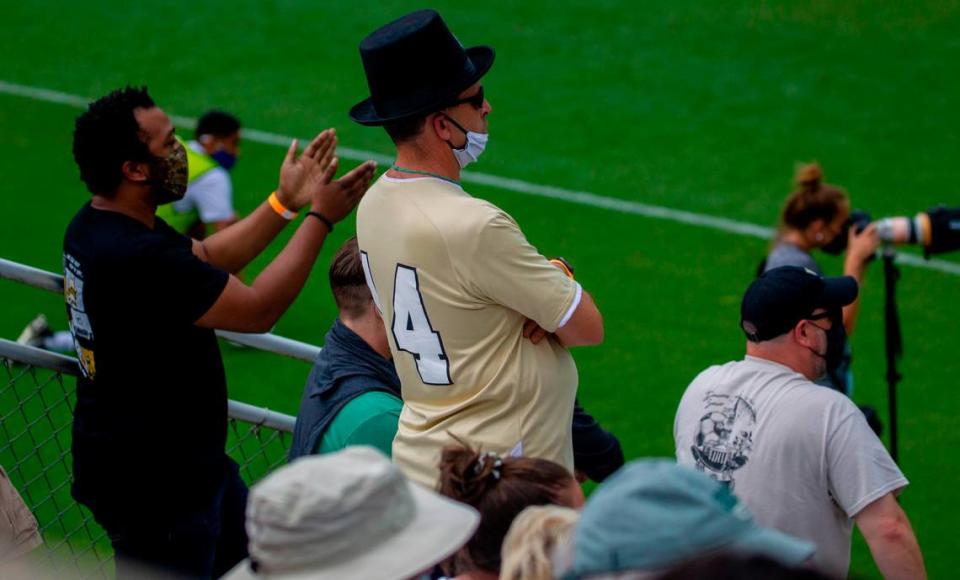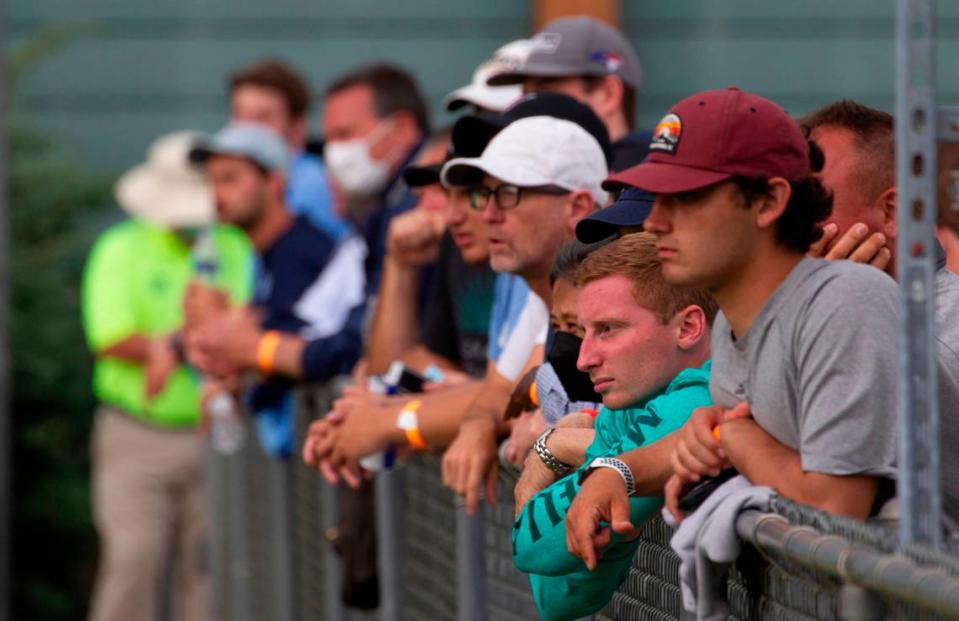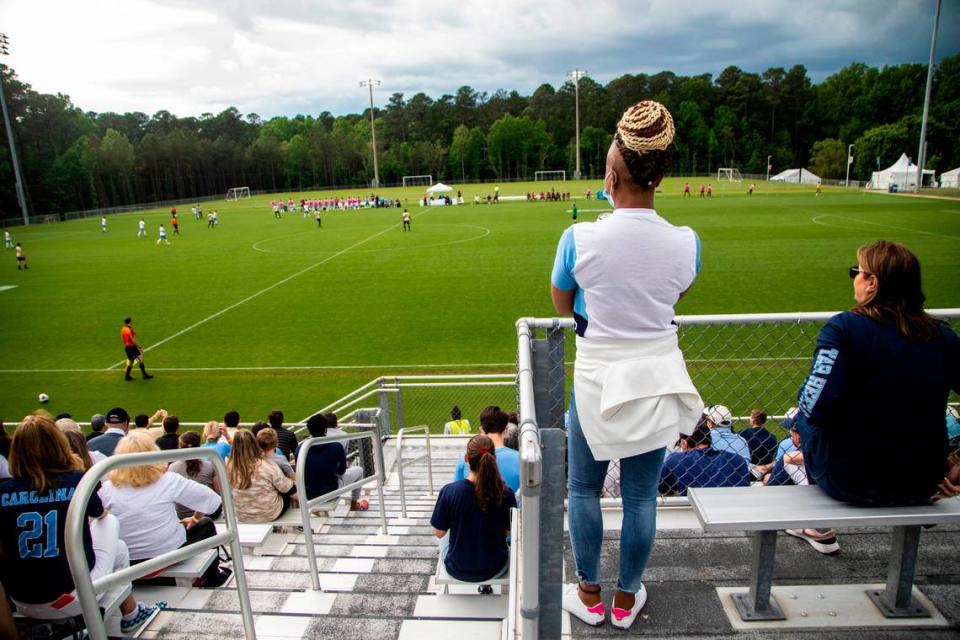NC pulls off improbable feat of hosting two NCAA soccer tourneys ... at the same time
Without fanfare, and without fans, WakeMed Soccer Park quietly pulled off one of the great athletic achievements in the state’s long history of success. Over the span of two days, using two fields, the Cary soccer mecca was the venue for the entire Sweet 16 of both the men’s and women’s NCAA soccer tournaments.
There was nonstop soccer from noon until past midnight, eight games Wednesday, eight games Thursday, with only one minor weather delay. It was a feat of logistics, planning, agronomy, ambition and not a little meteorological luck at the end of three weeks of the same.
The quarterfinals were a breeze by comparison, and as the first ever combined College Cup looms this weekend at the main stadium — with the women’s semifinals Thursday, the men’s Friday and both championship games on Monday — the state of North Carolina can look back and say it safely cleared what were expected to be the toughest hurdles in this improbable and audacious attempt to host both soccer tournaments simultaneously.
It took nine different sites — Campbell, East Carolina, UNC Greensboro, UNC Wilmington and Wake Forest, as well as off-campus complexes in Cary, Greensboro, Matthews and Wilson — but the end is in sight. So is an improbable pandemic success story, in the only state that had the ambition to try hosting two tournaments at once in the middle of a pandemic, and the ability to pull it off.
“If you were going to have a bubble, North Carolina was the place for the bubble,” Duke women’s soccer coach Robby Church said in an interview. “There’s always a little bit of a road to the finals. That road always led to WakeMed.”

Two tournaments, one bubble, one state
So how did both tournaments end up here, at so many venues across the state, anyway? It started more than seven months ago with a phone call from NCAA senior vice president Joni Comstock to Scott Dupree, the executive director of the Greater Raleigh Sports Alliance. Cary had been planning to host the women’s College Cup and added the men’s College Cup when fall sports were moved to the spring.
Could the organizers, Comstock asked, potentially cobble together a plan to pull off two entire tournaments? Simultaneously?
“We always try to go back and ask, where do we have experienced hosts who we think we can collaborate with and we could do something such as a large event like this?” Comstock said. “It’s something where you’ve got to have experience, so the health and safety protocols are followed. We have great relationships in this area and certainly with Scott Dupree and Cary.”
Such a thing had never been tried, and while the NCAA was forging ahead at the time to play the basketball tournaments in single sites (Indianapolis for the men, San Antonio for the women) as well as volleyball (in Omaha), soccer was a bigger ask, even without doubling the scale of the task by combining the two tournaments.
It’s easy to play a bunch of basketball games on the same court, over and over, day after day. Soccer fields can’t handle that kind of traffic. Nor do many meet the NCAA’s standards for tournament play. Nor are they indoors, with schedules immune to the whims of the weather. The logistics were exponentially more complicated.
WakeMed had in the past submitted bids to host both College Cups in the same year, and Dupree was on the record with the NCAA about wanting to become for college soccer what Omaha is to college baseball or Oklahoma City is to college softball.
But this was all of it.

Cary and WakeMed had years of experience of hosting NCAA championships, and had earned the NCAA’s confidence in the process. Dupree didn’t know if the combination of Cary, the GRSA and UNC — the host school for the women’s College Cup originally scheduled for December 2020, pre-COVID — could pull it off, but he was pretty sure if they couldn’t, no one else could either.
Dupree made his first call to William Davis, the sports venue manager for the Town of Cary and an NCAA hosting veteran. Dupree had the same questions for Davis that Comstock had for him: What did he think? Could they do it? Would the town even be interested?
Davis had a one-word answer: Absolutely.
“We can make anything happen, is kind of our bullheaded mentality,” Davis said in an interview. “It’s really nice when you’ve got the history that we’ve got of hosting a lot of different championships. We don’t have to go to our town council or town manager and ask. We kind of have a good gauge of what they’ll support. This was an event where we said, absolutely. And we think we’ve got the reputation with the NCAA that they would feel like we could pull it off.”
More than the usual suspects
Despite the optimism Davis and Dupree shared, they knew it wasn’t as easy as it might have looked on paper. Not only were they going to need a lot of soccer fields, some of the obvious choices were already booked. Duke’s campus was still off-limits to visitors. N.C. State was hosting the ACC track championships at its soccer stadium. Even UNC, technically the host school, was out.
North Carolina went from hosting one College Cup to both College Cups, to both tournaments in their entirety, but it would have its hands full with the ACC lacrosse and NCAA field hockey championships.
Not only would other venues be needed, those venues would have to be able to operate with some degree of autonomy. A core group of six started working the phones: Dupree, Davis, NCAA staffers Ryan Tressel and Kelly Whitaker, WakeMed Soccer Park supervisor Keith Jenkins and UNC’s John Brunner. It took months of searching, thinking, guessing and even cajoling, but five in-state colleges were willing and available. Still, they needed more.
Dupree, a Wilson native, pushed for his hometown, and not out of pride. He knew, and Davis knew, that Wilson’s soccer complex had some of the very few fields in the state that were equals to WakeMed Soccer Park’s famous pristine turf. The NCAA agreed to go off campus in Greensboro and Matthews, as well.
Cary was a given and had a number of fields available, but in the end settled on fields 2 and 4. Hosting two games simultaneously, even with a limited number of fans, was ambitious enough. Field 3 would be reserved for NC Courage and North Carolina FC training. Fields 6 and 7, without lights, would be used for team practices and weather contingencies.

On a back acre, the soccer park bought and stored an expanse of replacement sod, thick-cut Bermuda for instant emergency use. (In the event, it was only needed for light patching in the goalmouths.) The stadium itself would be used before the semifinals only in a schedule-crunch emergency.
“We told the NCAA we can use the stadium if we need it,” Davis said. “Their goal was, can we preserve the stadium for teams that really earn it?”
Meanwhile, some of the usual NCAA requirements — one team per hotel, welcome banquets, NCAA host schools — went out the window. Consolidating multiple teams in a hotel made COVID protocols easier; social events were obviously not an option under the circumstances.
Typically, although not always, a Division I school is a designated host at each site, with a staff that hosts home games on a regular basis, familiar with the NCAA manual covering everything from credentials to bathrooms. In Cary, Greensboro, Matthews and Wilson, the cities themselves were trusted to host instead. There was no other choice.
These were all moving parts for five months. Dupree never lost faith, but that doesn’t mean the to-do list ever got any shorter.
“Most of the work was working with the NCAA and (Cary) and many different partners and many different sites to put the puzzle together,” Dupree said in an interview. “We had to see if we could make it work to our satisfaction and the NCAA’s satisfaction.”
On March 26, the NCAA announced that both tournaments — the 48-team women’s tournament and the 36-team men’s tournament — would be played entirely within the borders of North Carolina, and conclude with a first-ever men’s-women’s doubleheader in Cary.
‘It feels important. It feels special.’
It’s been a different kind of experience for the players, in some ways a better one, even with limited attendance. While the NCAA took heavy and deserved criticism for the very different experiences of men’s and women’s basketball players in everything from weight rooms to swag bags, the soccer operation was constructed in a gender-neutral way out of necessity.
Given the length of the tournament and the number of days between games, the NCAA asked the hosts to prepare a menu of off-day activities. Every team, men’s or women’s, was offered the same opportunities, from open gyms and yoga studios to golf and video games. Want to watch a movie? A team could have a theater to itself. Need a pep talk? Jessica McDonald from the NC Courage and U.S. National Team was on call.
The men’s and women’s teams stayed in the same hotels. They used the same fields. The only difference between the two tournaments was the brackets.
That crossover has brought a social aspect to the tournaments that’s usually lacking. Teams are typically sequestered in their hotels, living monastically. But there were four teams at the Sheraton in downtown Raleigh last week: The Duke and UCLA women and the Georgetown and Seton Hall men, sharing their own little soccer bubble.
“We have all the teams in one place and we can see the other teams, even on the men’s side,” Duke goalie Ruthie Jones said in an interview. “We get to watch all the games on TV or in the hotel and see everything as it unfolds. It’s exciting. It feels important. It feels special.”

Some of the host sites had the same sense of novelty. It was a big deal when the UCLA women played at Campbell. The Camels even got to host their own-first round game against Iowa. There aren’t a lot of Big Ten or Pac-12 teams that make their way to Buies Creek.
It was an even bigger deal in Wilson, where the closest any Division I teams ever get is a dinner stop off I-95. The Wilson Times devoted multiple pages of its sports section daily to the six games there, which included the South Carolina, Georgetown and TCU women. Those are the tangible benefits, for towns and teams and the NCAA alike, of taking these tournaments to places they don’t typically go.
Through the quarterfinals, in-state teams are 10-7, with one actual home-field advantage (the Campbell women) and one partial. A few years ago, while Fetzer Field was being renovated, North Carolina played parts of two seasons on WakeMed’s Field 2. That same patch of pitch was the scene of the Tar Heel men’s 1-0 upset of fourth-seeded Stanford last Thursday night. A few of the players who called that turf home are still on the UNC roster. Coincidence? North Carolina was the only school to make both the men’s and women’s College Cup.
Clearing the final logistical hurdle
The one obvious bottleneck from the beginning was the frantic back-to-back Sweet 16s on the two outlying fields at WakeMed Soccer park, separated only by a parking lot, where even a little bit of bad weather could delay two games at once and wreak havoc with the schedule for days. There’s a long history of NCAA baseball in North Carolina (too long!) where spring thunderstorms have not only delivered interminable delays but diverted the path of fate entirely.
The third pair of women’s games Wednesday not only both went to overtime but sat through an hour-long rain and lightning delay -- one before the game went to penalty kicks, the other, awkwardly, after the first penalty kick of the shootout. The late games finished after midnight, but they finished. The soccer park’s other fields and contingency plans sat idle.
“We are incredibly grateful, whether it’s for the quality of the facilities or the fantastic staff, but then also aided by the weather,” the NCAA’s Comstock said.

Friday morning, hours after Wake Forest and Seton Hall won to conclude Thursday night’s men’s games, it hailed on the empty fields.
There was another, shorter delay during Monday night’s quarterfinals, but given the stakes and circumstances, that’s not bad. After 76 games, there are only six left, all on college soccer’s biggest stage at WakeMed Soccer Park. North Carolina is one of three ACC teams in the women’s College Cup. The Tar Heels will be one of two on the men’s side after North Carolina beat Wake Forest 2-1 on Monday for the right to move into the stadium next door.
“It feels like a tournament experience, which is good,” North Carolina men’s coach Carlos Somoano said. “I have to give credit to the NCAA championship committee. This is not easy. Sure, they haven’t gotten everything perfect, but golly, you have to give them a lot of credit for pulling this off and giving all the teams a championship experience. To me, it feels like it.”
Two teams will be crowned as champions. One state’s already feeling like it won.

 Yahoo Finance
Yahoo Finance 